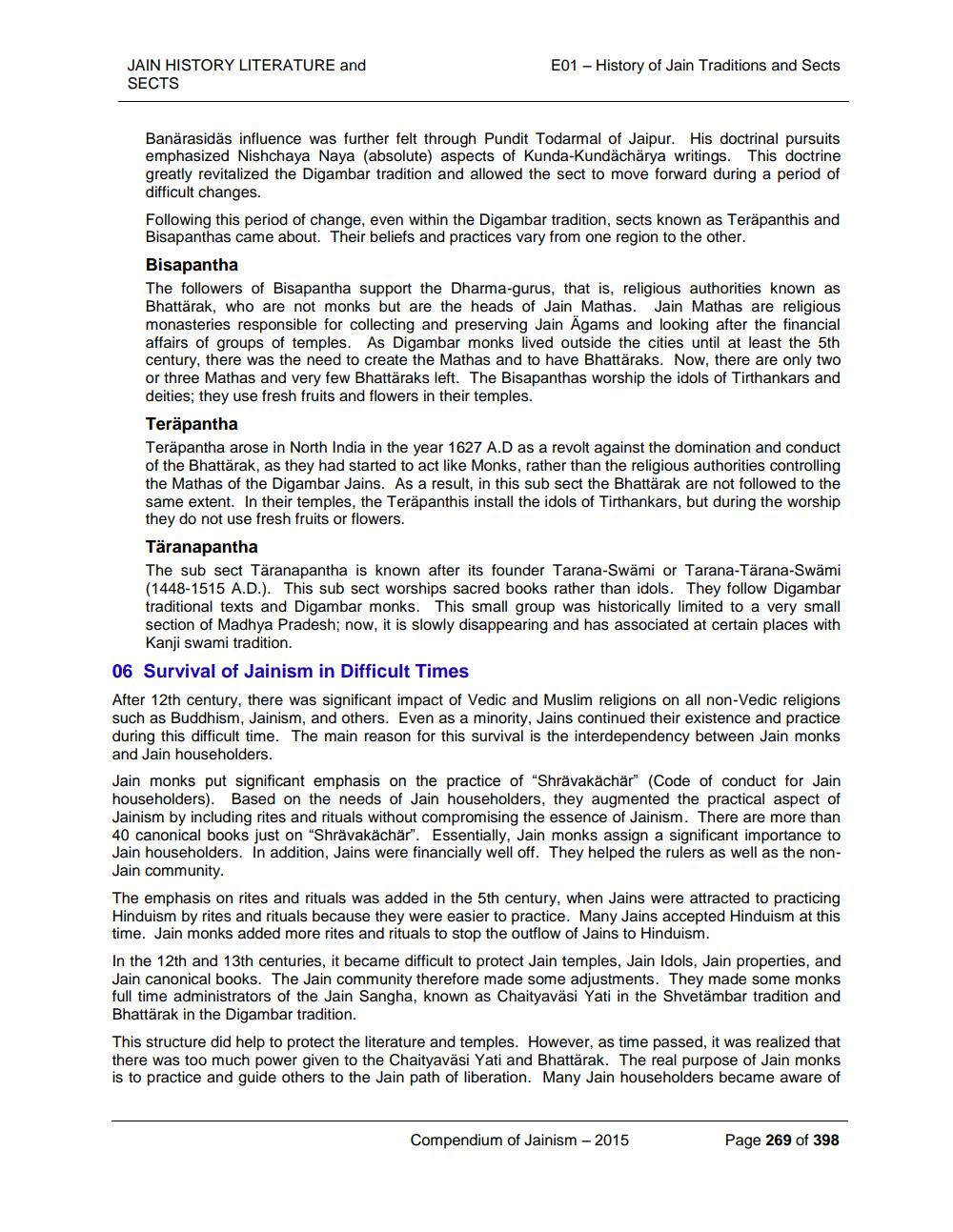________________
JAIN HISTORY LITERATURE and SECTS
E01 - History of Jain Traditions and Sects
Banarasidäs influence was further felt through Pundit Todarmal of Jaipur. His doctrinal pursuits emphasized Nishchaya Naya (absolute) aspects of Kunda-Kundächärya writings. This doctrine greatly revitalized the Digambar tradition and allowed the sect to move forward during a period of difficult changes. Following this period of change, even within the Digambar tradition, sects known as Teräpanthis and Bisapanthas came about. Their beliefs and practices vary from one region to the other.
Bisapantha The followers of Bisapantha support the Dharma-gurus, that is, religious authorities known as Bhattarak, who are not monks but are the heads of Jain Mathas. Jain Mathas are religious monasteries responsible for collecting and preserving Jain Ägams and looking after the financial affairs of groups of temples. As Digambar monks lived outside the cities until at least the 5th century, there was the need to create the Mathas and to have Bhattaraks. Now, there are only two or three Mathas and very few Bhattäraks left. The Bisapanthas worship the idols of Tirthankars and deities; they use fresh fruits and flowers in their temples. Teräpantha Teräpantha arose in North India in the year 1627 A.D as a revolt against the domination and conduct of the Bhattarak, as they had started to act like Monks, rather than the religious authorities controlling the Mathas of the Digambar Jains. As a result, in this sub sect the Bhattarak are not followed to the same extent. In their temples, the Teräpanthis install the idols of Tirthankars, but during the worship they do not use fresh fruits or flowers. Täranapantha The sub sect Taranapantha is known after its founder Tarana-Swami or Tarana-Tarana-Swami (1448-1515 A.D.). This sub sect worships sacred books rather than idols. They follow Digambar traditional texts and Digambar monks. This small group was historically limited to a very small section of Madhya Pradesh; now, it is slowly disappearing and has associated at certain places with
Kanji swami tradition. 06 Survival of Jainism in Difficult Times After 12th century, there was significant impact of Vedic and Muslim religions on all non-Vedic religions such as Buddhism, Jainism, and others. Even as a minority, Jains continued their existence and practice during this difficult time. The main reason for this survival is the interdependency between Jain monks and Jain householders. Jain monks put significant emphasis on the practice of "Shrävakächär" (Code of conduct for Jain householders). Based on the needs of Jain householders, they augmented the practical aspect of Jainism by including rites and rituals without compromising the essence of Jainism. There are more than 40 canonical books just on "Shrävakächär". Essentially, Jain monks assign a significant importance to Jain householders. In addition, Jains were financially well off. They helped the rulers as well as the nonJain community. The emphasis on rites and rituals was added in the 5th century, when Jains were attracted to practicing Hinduism by rites and rituals because they were easier to practice. Many Jains accepted Hinduism at this time. Jain monks added more rites and rituals to stop the outflow of Jains to Hinduism. In the 12th and 13th centuries, it became difficult to protect Jain temples, Jain Idols, Jain properties, and Jain canonical books. The Jain community therefore made some adjustments. They made some monks full time administrators of the Jain Sangha, known as Chaityaväsi Yati in the Shvetämbar tradition and Bhattarak in the Digambar tradition. This structure did help to protect the literature and temples. However, as time passed, it was realized that there was too much power given to the Chaityaväsi Yati and Bhattarak. The real purpose of Jain monks is to practice and guide others to the Jain path of liberation. Many Jain householders became aware of
Compendium of Jainism - 2015
Page 269 of 398




